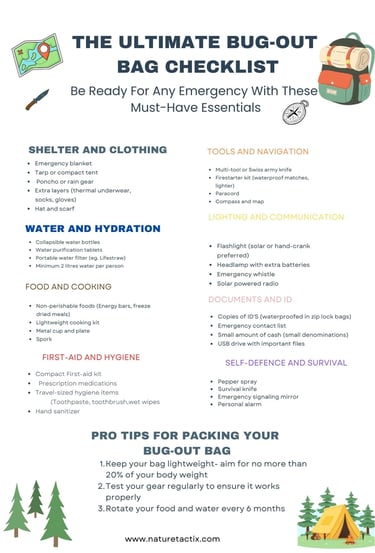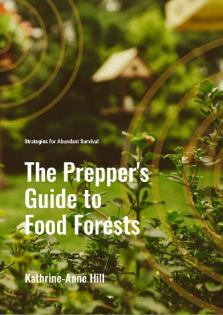Bug-Out Bag Essentials: What Every Prepper Should Carry
Discover the must-have items for your bug-out bag to ensure you’re fully prepared for any emergency or survival situation. From tools and first aid to food and water supplies, our comprehensive guide covers everything you need to build a reliable bug-out bag. Whether you're a beginner or a seasoned prepper, find the right gear to stay safe and survive when disaster strikes.
PREPPING POSTS
Kathrine-Anne Hill
10/2/20247 min read


Affiliate Disclosure:
Please note that some of the links in this article are affiliate links. This means that if you click on these links and make a purchase, I may receive a small commission at no additional cost to you. This commission helps support the maintenance and growth of this website and allows me to continue providing valuable information and recommendations. Rest assured, I only recommend products and services that I have personally used or thoroughly researched. Your support is greatly appreciated! “As an Amazon Associate I earn from qualifying purchases.” For full disclosure see our Privacy Policy and Terms and Conditions here.
Why Every Prepper Needs a Bug-Out Bag
In today's unpredictable world, the need for a well-prepared bug-out bag has become increasingly clear. Natural disasters, civil unrest, and unexpected emergencies can occur without warning. For every prepper, having a bug-out bag is essential as it acts as a vital lifeline in these situations. This bag, carefully packed with necessary items, can greatly improve one’s chances of survival during an unplanned evacuation.
There are several scenarios that may require a bug-out bag. For example, in the case of a wildfire or flood, families might need to evacuate their homes within minutes. Similarly, during civil disturbances or significant power outages, being ready to leave can help individuals respond swiftly and effectively. Additionally, the threat of pandemics or health crises may drive people to seek refuge in more rural, less populated areas. Therefore, a bug-out bag ensures that individuals are prepared to shift to off-grid living when the situation calls for it.
Beyond the practical benefits of having a bug-out bag, there are also important psychological advantages tied to being prepared. Knowing that one is ready to handle potential emergencies brings a sense of security and peace of mind. Instead of giving in to anxiety during uncertain times, preppers can face crises with confidence, aware that they have the necessary tools at hand. This mental readiness is just as crucial as physical preparedness; it empowers individuals to make sound decisions under pressure.
In conclusion, the significance of a bug-out bag cannot be emphasized enough. In a time characterized by unpredictability, adopting preparedness through a well-stocked bag not only supports survival but also fosters a proactive mindset that is essential for effectively managing emergencies.
Essential Items for Your Bug-Out Bag
Putting together a practical bug-out bag requires thoughtful selection of key items that will aid your survival in emergencies. A well-stocked bag can be your lifeline, ensuring you have the necessary supplies to keep you going until help arrives or you can find a safe place.
First and foremost, including a thorough first-aid kit is essential. This kit should have bandages, antiseptics, pain relievers, and any personal medications you might need. The GOODONE2 Mini First Aid Kit is nice and compact in a water-resistant case. A multi-tool, like a Swiss Army knife, can also be incredibly useful, providing various functions such as cutting and opening, which are crucial in any survival situation. The Leatherman Wave Plus. is renowned for its durability and versatility.
When it comes to cooking supplies, having portable cooking gear is beneficial. Compact camping stoves and lightweight cookware enable you to prepare meals easily. The MSR PocketRocket Deluxe comes with a lightweight cooking pot. Including freeze-dried meals or Meals Ready to Eat (MREs) gives you nutritious options that require little preparation and have a long shelf life. The Mountain House 72-Hour Emergency Food Supply has a variety of meals, and come in compact sealed pouches that have a 30 year life span.
Water is critical, so a dependable water purification system should be part of your bag. This could include portable water filters or purification tablets, ensuring you have safe drinking water in various environments. The LifeStraw Peak Series are ultralight and have an unlimited shelf life. Additionally, it’s smart to keep important documents like identification, medical records, and insurance information in your bag. Using a waterproof pouch can help protect these documents from the elements. The Haisskey Cellphone Waterproof Pouches are a great option.
Clothing is another vital category. Pack weather-appropriate clothing and sturdy footwear to improve your comfort during a bug-out situation. Look for moisture-wicking and quick-drying fabrics. Finally, think about including shelter items like a compact tent or emergency space blankets, which can offer protection and warmth in unexpected circumstances. The Go Time Gear Survival Life Tent is a 2-person emergency tent and the size of a pop can.
This checklist is a basic starting point for your bug-out bag, but your personal needs may require additional items. It’s important to regularly review and adjust your bag based on changing situations and individual requirements. By carefully choosing each item, you can ensure your preparedness for any emergency.
Organizing Your Bug-Out Bag for Maximum Efficiency
Properly organizing your bug-out bag is crucial for ensuring quick access and effective operation during emergencies. To accomplish this, it's important to pack items thoughtfully and with intention. A great practice is to group similar items together. For instance, keep all first aid supplies in one section of the bag, while cooking utensils and food rations are stored close by. By categorizing your gear, you can quickly find what you need, which is essential during a stressful evacuation.
Using waterproof bags is another effective strategy. Items that can be damaged by water, such as clothing, important documents, and electronics, should be stored in these protective bags. This way, your essential supplies stay dry no matter the weather. Additionally, consider using smaller bags within your bug-out bag to further organize your gear, making it easier to rearrange and access items as needed. OTraki Waterproof Laundry Bags can keep your clothing nice and dry, or if your clothes get wet, you can place them in it if you don't have time to let them dry.
When packing your bug-out bag, it's also vital to think about weight distribution. Placing heavier items at the bottom improves the bag's stability, making it easier to carry over long distances. This not only lessens the strain on your back but also reduces the chance of tipping the bag over, which can cause disarray. Furthermore, incorporating lightweight gear where possible maximizes space without adding unnecessary weight.
Regularly check the contents of your bug-out bag to ensure you're prepared for different situations. Inspect perishable items and rotate them to prevent expiration. An organized bug-out bag can also be adjusted according to the seasons or potential threats, tailoring the contents to meet changing needs. Ultimately, the aim is to create a bug-out bag that is ready for immediate use while remaining manageable and efficient over time.
Customizing Your Bug-Out Bag for Personal Needs
Customizing a bug-out bag is essential to ensure it meets the unique needs of the individual preparing for emergencies. One key factor to consider is geographic location. Different areas are susceptible to various types of disasters—such as flooding, wildfires, or earthquakes—which means specific items should be included in the bug-out bag. For example, someone living near the coast might prioritize items like a life jacket or waterproof gear, while a person in a mountainous area may need climbing equipment or a first-aid kit designed for altitude sickness.
Climate also significantly influences how a bug-out bag should be customized. Individuals facing extreme heat or cold should pack appropriate clothing and survival gear. Cold weather may require insulated items like thermal blankets, layered clothing, or portable heat packs, while those in warmer climates might need sun protection items such as sunscreen and wide-brimmed hats. Additionally, it’s important to consider seasonal changes that could affect preparedness needs over time.
Family size and dynamics should not be ignored when putting together a bug-out bag. For families, it may be necessary to include specific items for children or elderly members, such as diapers, baby formula, or mobility aids. Furthermore, items for pets should also be part of the family evacuation plan, ensuring that all members—both two-legged and four-legged—are adequately provided for. Regularly reviewing the contents of the bag is wise and necessary, as personal health needs and lifestyle changes may require updates. Checking for expired food supplies, outgrown clothing, or changes in medical needs will help keep the bug-out bag effective when it’s needed.
Access this checklist from the link below:
Related Posts:
The Ultimate Guide to the Best Multi-Tools for Wilderness Survival
The Ultimate Guide to Creating a Budget-Friendly Wilderness Survival Kit
The Ultimate Guide to the Best Survival Knives for Wilderness Survival










The Prepper's Guide to Food Forests: Strategies for Abundant Survival is a concise, step-by-step guide to creating a self-sustaining food forest. Ideal for preppers, it covers essential topics like design, plant selection, permaculture, companion planting, and wildlife integration. Learn how to maintain your forest, boost yields, and make it part of your survival strategy.
Highlights:
Basics of food forests and their benefits
Designing and selecting resilient plants
Creating a self-sustaining ecosystem
Using permaculture and companion planting
Maintenance, harvesting, and wildlife habitats
Food forests as part of a prepper strategy
Perfect for anyone seeking long-term food security.
Sign-Up and receive my FREE eBook The Prepper's Guide to Food Forests: Strategies for Abundant Survival !
As always, be sure to check our website for more wilderness tips and gear updates!
